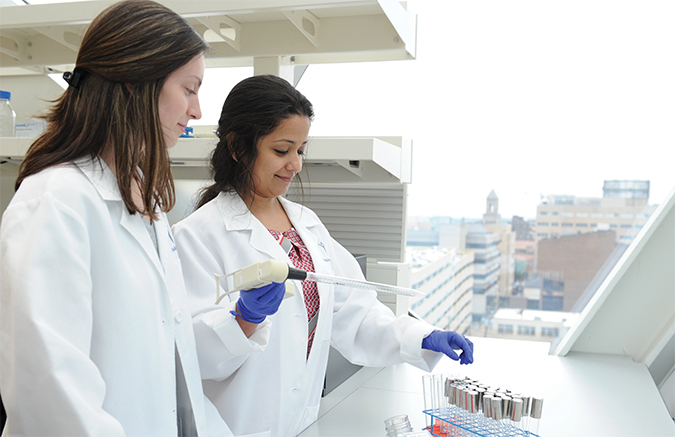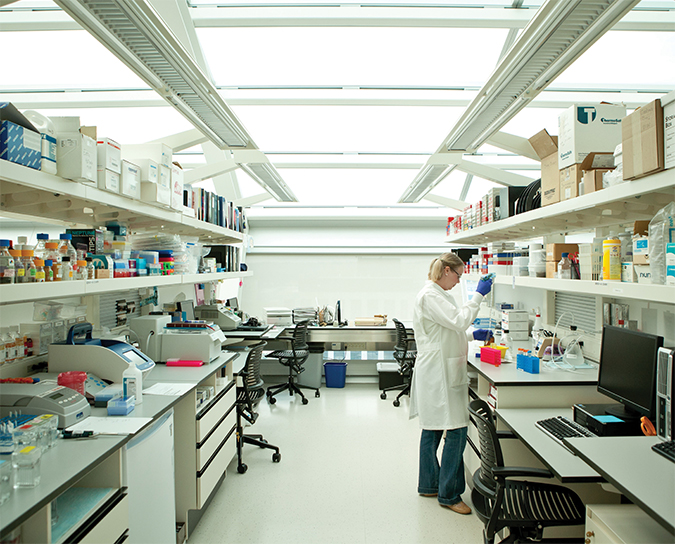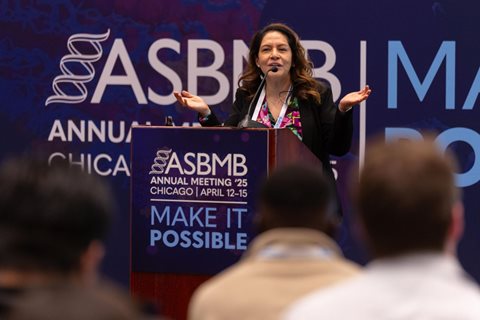Consider a career at an independent research institution
Researchers in the U.S. work in public and private colleges and universities, in government, in industry, and at independent research institutions. While the last category may not be as familiar as the first three, most scientists have certainly heard of the Fred Hutchinson Cancer Research Center, Jackson Laboratory and Cold Spring Harbor Laboratory.
IRIs are diverse in terms of their missions and sizes. They often have focused research interests, but the almost 80 U.S. research IRIs that belong to the Association of Independent Research Institutes collectively cover areas ranging from fundamental biochemistry to translational biomedicine to oceanography. Scientists at Van Andel Institute in Grand Rapids, Michigan, work primarily on cancer epigenetics and Parkinson’s disease, while the Stowers Institute for Medical Research in Kansas City, Missouri, focuses on basic biomedical research.
At the Oklahoma Medical Research Foundation in Oklahoma City, Courtney Griffin leads one of 10 laboratories in the cardiovascular biology research program. “Our programs tend to be focused around tighter topic areas than a traditional academic department,” she said. “This is different from a large department at an academic institution, which has a broad teaching mission and therefore has to cover a lot of diverse topic areas.”
In many cases, a person or family endows an IRI to fund research on a specific disease or topic, such as Van Andel Institute. In other cases, groups establish IRIs, such as City of Hope in Duarte, California, to serve needs in their communities. IRIs vary in size from only a few employees at their inception to hundreds or even thousands as they mature and grow.
 Van Andel Institute Graduate School uses problem-based learning, a student-centered approach where students work in teams to solve problems.Van Andel InstituteWhile some IRIs have close relationships with universities, they are all by definition independent and operate under their own authority. Scientists at IRIs fill all the roles traditionally seen in academia — students, postdoctoral fellows, professional research staff (staff scientists, technicians, core managers), and faculty.
Van Andel Institute Graduate School uses problem-based learning, a student-centered approach where students work in teams to solve problems.Van Andel InstituteWhile some IRIs have close relationships with universities, they are all by definition independent and operate under their own authority. Scientists at IRIs fill all the roles traditionally seen in academia — students, postdoctoral fellows, professional research staff (staff scientists, technicians, core managers), and faculty.
Many IRIs support their own graduate programs, which tend to be smaller than traditional university programs. The application process is similar, but each program focuses on its institution’s research, so competitive applicants must demonstrate a clear interest in that field. Graduate students who are unsure of their interests may prefer the broader offerings of a traditional university. The Stowers Institute and VAI both have independent graduate schools, while the OMRF participates in a cooperative program with the University of Oklahoma Health Sciences Center.
Minge Du is a graduate student at Van Andel Institute Graduate School. She was initially reluctant to leave Stony Brook University and follow her PI to a place she’d never heard of, but she now sees the benefits. “The VAIGS curriculum uses problem-based learning,” she said, referring to a student-centered approach where students work in teams to solve problems. “This style promotes student motivation and self-learning and cultivates collaboration between students and faculty, which allows students to be more involved in the process of learning.”
Most IRIs support postdoctoral training programs. Some are similar to those at universities, but others take unique approaches to supporting postdocs. VAI considers all postdocs to be employees, and they receive full employee benefits and salaries above the National Institutes of Health stipend recommendations. As with any postdoc job search, candidates considering these programs should take into account their own research interests, available financial and professional development resources from the mentor and institution, and historical career outcomes of the lab and training program.
Benjamin Johnson chose to accept a postdoc position at VAI because of the “accessibility and resource support — both from a faculty/personnel standpoint and research resources angle. The direct result of this is a shorter time frame to go from a research idea or hypothesis to performing the experiment.”
Eulália Lima da Silva is doing her postdoctoral training at the OMRF because the institute is committed to innovation. “We are using cutting-edge technologies to understand, treat and cure diseases,” she said. “OMRF has the mission of giving back to the community and aids in helping Oklahomans live longer, healthier and happier lives.”
 A Van Andel Institute Graduate School student works in a lab. The institute’s research focuses primarily on cancer epigenetics and Parkinson’s disease. Labs are designed to promote collaboration.Van Andel InstituteFor early-career scientists starting their research programs, the IRI search process and level of competitiveness is similar to universities. Many institutes have substantial endowments and receive generous philanthropic support, which can be used to support early-career faculty members, develop preliminary data and purchase equipment.
A Van Andel Institute Graduate School student works in a lab. The institute’s research focuses primarily on cancer epigenetics and Parkinson’s disease. Labs are designed to promote collaboration.Van Andel InstituteFor early-career scientists starting their research programs, the IRI search process and level of competitiveness is similar to universities. Many institutes have substantial endowments and receive generous philanthropic support, which can be used to support early-career faculty members, develop preliminary data and purchase equipment.
Matthew Gibson is an investigator at the Stowers Institute for Medical Research. “The freedom afforded by generous support from the institute allows us to pursue truly curiosity-driven research on fundamental biological questions,” he said.
IRIs often can adapt and pivot more quickly than larger institutions. The small size of some IRIs may not appeal to all investigators, but Scott Rothbart, an associate professor at VAI, said, “Because we are small, we are nimble and rapidly responsive to the needs of our scientists. I saw the small size of the institute as a major strength in having a voice in decisions shaping the growth of the institute, even as a junior faculty member.”
All the scientists interviewed for this article mentioned their colleagues and institutional support. Gibson said, “The level of internal support for both the labs and core facilities opens up all kinds of new possibilities and gives scientists the rare chance to move their research program in completely new directions, both technically and intellectually. I was most attracted by the opportunity to engage new technology through the cores and the chance to do truly open-ended and curiosity-driven research.”
Rothbart said, “My faculty colleagues are world-renowned experts in the (epigenetics) field. Maybe it’s because we are small, or because we are a close-knit community of scientists and support staff, but one of my favorite aspects of running a lab at VAI is that our successes and the successes of my colleagues are shared among the entire institute.”
 Endowments and philanthropic support enable institutes to purchase equipment such as that pictured here in one of the VAI labs.Van Andel Institute
Endowments and philanthropic support enable institutes to purchase equipment such as that pictured here in one of the VAI labs.Van Andel Institute
Enjoy reading ASBMB Today?
Become a member to receive the print edition four times a year and the digital edition monthly.
Learn moreFeatured jobs
from the ASBMB career center
Get the latest from ASBMB Today
Enter your email address, and we’ll send you a weekly email with recent articles, interviews and more.
Latest in Careers
Careers highlights or most popular articles

Building the blueprint to block HIV
Wesley Sundquist will present his work on the HIV capsid and revolutionary drug, Lenacapavir, at the ASBMB Annual Meeting, March 7–10, in Maryland.

Upcoming opportunities
Present your research alongside other outstanding scientists. The #ASBMB26 late-breaking abstract deadline is Jan. 15.

Designing life’s building blocks with AI
Tanja Kortemme, a professor at the University of California, San Francisco, will discuss her research using computational biology to engineer proteins at the 2026 ASBMB Annual Meeting.

Upcoming opportunities
#ASBMB26 late-breaking abstract submission opens on December 8. Register by Jan. 15 to get the early rate on our Annual Meeting.

Make your abstract stand out
Ensure your research is impossible to overlook. Get quick, practical reminders for crafting an abstract that attracts readers and helps you build connections at the conference.

Inside industry postdocs
As more Ph.D. scientists look beyond academia, industry postdocs offer a new kind of training, where mentorship meets mission-driven research. Fellows at Pfizer and Genentech share how these programs prepare them to translate discovery into impact.

